Impact of Silicon Nanoparticles on the Antioxidant Compounds of Tomato Fruits Stressed by Arsenic
Abstract
1. Introduction
2. Materials and Methods
2.1. Fruit Sampling
2.2. Fruit Quality
2.3. Biochemical Analysis
2.4. Arsenic Determination
2.5. Statistical Analysis
3. Results
3.1. Arsenic Determination
3.2. Fruit Quality
3.3. Proteins
3.4. Antioxidant Compounds
3.5. Antioxidant Capacity
3.6. Hydrogen Peroxide Content
4. Discussion
5. Conclusions
Author Contributions
Funding
Conflicts of Interest
References
- García-Martí, M.; Piñero, M.C.; García-Sanchez, F.; Mestre, T.C.; López-Delacalle, M.; Martínez, V.; Rivero, R.M. Amelioration of the oxidative stress generated by simple or combined abiotic stress through the K+ and Ca2+ supplementation in tomato plants. Antioxidants 2019, 8, 81. [Google Scholar] [CrossRef]
- Salehi, B.; Sharifi-Rad, R.; Sharopov, F.; Namiesnik, J.; Roointan, A.; Kamle, M.; Kumar, P.; Martins, N.; Sharifi-Rad, J. Beneficial effects and potential risks of tomato consumption for human health: An overview. Nutrition 2019, 62, 201–208. [Google Scholar] [CrossRef] [PubMed]
- Stajčić, S.; Ćetković, G.; Čanadanović-Brunet, J.; Djilas, S.; Mandić, A.; Četojević-Simin, D. Tomato waste: Carotenoids content, antioxidant and cell growth activities. Food Chem. 2015, 172, 225–232. [Google Scholar] [CrossRef] [PubMed]
- Xie, B.-x.; Wei, J.-j.; Zhang, Y.-t.; Song, S.-w.; Su, W.; Sun, G.-w.; Hao, Y.-w.; Liu, H.-c. Supplemental blue and red light promote lycopene synthesis in tomato fruits. J. Integr. Agric. 2019, 18, 590–598. [Google Scholar] [CrossRef]
- Azeez, L.; Adeoye, M.D.; Majolagbe, T.A.; Lawal, A.T.; Badiru, R. Antioxidant activity and phytochemical contents of some selected Nigerian fruits and vegetables. Am. J. Anal. Chem. 2012, 2, 209–213. [Google Scholar]
- Kim, D.-O.; Padilla-Zakour, O.I.; Griffiths, P.D. Flavonoids and Antioxidant Capacity of Various Cabbage Genotypes at Juvenile Stage. J. Food Sci. 2004, 69, 685–689. [Google Scholar] [CrossRef]
- Cao, S.-Y.; Zhao, C.-N.; Gan, R.-Y.; Xu, X.-Y.; Wei, X.-L.; Corke, H.; Atanasov, A.G.; Li, H.-B. Effects and mechanisms of tea and its bioactive compounds for the prevention and treatment of cardiovascular diseases: An updated review. Antioxidants 2019, 8, 166. [Google Scholar] [CrossRef]
- Otero, X.L.; Tierra, W.; Atiaga, O.; Guanoluisa, D.; Nunes, L.M.; Ferreira, T.O.; Ruales, J. Arsenic in rice agrosystems (water, soil and rice plants) in Guayas and Los Ríos provinces, Ecuador. Sci. Total Environ. 2016, 573, 778–787. [Google Scholar] [CrossRef]
- Zvobgo, G.; Lwalaba, J.L.W.; Sagonda, T.; Mapodzeke, J.M.; Muhammad, N.; Shamsi, I.H.; Zhang, G.-p. Alleviation of arsenic toxicity by phosphate is associated with its regulation of detoxification, defense, and transport gene expression in barley. J. Integr. Agric. 2019, 18, 381–394. [Google Scholar] [CrossRef]
- Heikens, A. Arsenic Contamination of Irrigation Water, Soil and Crops in Bangladesh: Risk Implications for Sustainable Agriculture and Food Safety in Asia; RAP Publication 2006/20; Food and Agriculture Organization of the United Nations, Regional Office for Asia and the Pacific: Bangkok, Thailand, 2006. [Google Scholar]
- Ruíz-Huerta, E.A.; de la Garza Varela, A.; Gómez-Bernal, J.M.; Castillo, F.; Avalos-Borja, M.; SenGupta, B.; Martínez-Villegas, N. Arsenic contamination in irrigation water, agricultural soil and maize crop from an abandoned smelter site in Matehuala, Mexico. J. Hazard. Mater. 2017, 339, 330–339. [Google Scholar] [CrossRef]
- Althobiti, R.A.; Sadiq, N.W.; Beauchemin, D. Realistic risk assessment of arsenic in rice. Food Chem. 2018, 257, 230–236. [Google Scholar] [CrossRef] [PubMed]
- Liao, X.; Fu, Y.; He, Y.; Yang, Y. Occurrence of arsenic in fruit of mango plant (Mangifera indica L.) and its relationship to soil properties. Catena 2014, 113, 213–218. [Google Scholar] [CrossRef]
- Marmiroli, M.; Pigoni, V.; Savo-Sardaro, M.L.; Marmiroli, N. The effect of silicon on the uptake and translocation of arsenic in tomato (Solanum lycopersicum L.). Environ. Exp. Bot. 2014, 99, 9–17. [Google Scholar] [CrossRef]
- Marmiroli, M.; Mussi, F.; Imperiale, D.; Lencioni, G.; Marmiroli, N. Abiotic stress response to As and As + Si, composite reprogramming of fruit metabolites in tomato cultivars. Front. Plant Sci. 2017, 8, 1–17. [Google Scholar] [CrossRef]
- Finnegan, P.M.; Chen, W. Arsenic toxicity: The effects on plant metabolism. Front. Physiol. 2012, 3, 1–18. [Google Scholar] [CrossRef]
- Mitra, A.; Chatterjee, S.; Moogouei, R.; Gupta, D. Arsenic accumulation in rice and probable mitigation approaches: A review. Agronomy 2017, 7, 67. [Google Scholar] [CrossRef]
- George, B.; Kaur, C.; Khurdiya, D.S.; Kapoor, H.C. Antioxidants in tomato (Lycopersium esculentum) as a function of genotype. Food Chem. 2004, 84, 45–51. [Google Scholar] [CrossRef]
- Jimenez, A.; Creissen, G.; Kular, B.; Firmin, J.; Robinson, S.; Verhoeyen, M.; Mullineaux, P. Changes in oxidative processes and components of the antioxidant system during tomato fruit ripening. Planta 2002, 214, 751–758. [Google Scholar] [CrossRef]
- De la Rosa, G.; García-Castañeda, C.; Vázquez-Núñez, E.; Alonso-Castro, Á.J.; Basurto-Islas, G.; Mendoza, Á.; Cruz-Jiménez, G.; Molina, C. Physiological and biochemical response of plants to engineered NMs: Implications on future design. Plant Physiol. Biochem. 2017, 110, 226–235. [Google Scholar] [CrossRef]
- Juárez-Maldonado, A.; Ortega-Ortiz, H.; González-Morales, S.; Morelos-Moreno, Á.; Cabrera-de la Fuente, M.; Sandoval-Rangel, A.; Cadenas-Pliego, G.; Benavides-Mendoza, A. Nanoparticles and nanomaterials as plant biostimulants. Int. J. Mol. Sci. 2019, 20, 162. [Google Scholar] [CrossRef]
- Hernández-Hernández, H.; González-Morales, S.; Benavides-Mendoza, A.; Ortega-Ortiz, H.; Cadenas-Pliego, G.; Juárez-Maldonado, A. Effects of chitosan–PVA and Cu nanoparticles on the growth and antioxidant capacity of tomato under saline stress. Molecules 2018, 23, 178. [Google Scholar] [CrossRef] [PubMed]
- Alsaeedi, A.; El-Ramady, H.; Alshaal, T.; El-Garawany, M.; Elhawat, N.; Al-Otaibi, A. Silica nanoparticles boost growth and productivity of cucumber under water deficit and salinity stresses by balancing nutrients uptake. Plant Physiol. Biochem. 2019, 139, 1–10. [Google Scholar] [CrossRef] [PubMed]
- Adrees, M.; Abbas, F.; Zia-ur-Rehman, M.; Ibrahim, M.; Rizwan, M.; Ali, S.; Farid, M.; Irshad, M.K.; Qayyum, M.F. Mechanisms of silicon-mediated alleviation of heavy metal toxicity in plants: A review. Ecotoxicol. Environ. Saf. 2015, 119, 186–197. [Google Scholar] [CrossRef] [PubMed]
- Sanglard, L.M.V.P.; Martins, S.C.V.; Detmann, K.C.; Silva, P.E.M.; Lavinsky, A.O.; Silva, M.M.; Detmann, E.; Araújo, W.L.; DaMatta, F.M. Silicon nutrition alleviates the negative impacts of arsenic on the photosynthetic apparatus of rice leaves: An analysis of the key limitations of photosynthesis. Physiol. Plant. 2014, 152, 355–366. [Google Scholar] [CrossRef]
- Steiner, A.A. A universal method for preparing nutrient solutions of a certain desired composition. Plant Soil 1961, 15, 134–154. [Google Scholar] [CrossRef]
- USDA. United States Standards for Grades of Fresh Tomatoes; USDA: Washington, DC, USA, 1991; pp. 1–13.
- Lopez-Vargas, E.R.; Ortega-ortiz, H.; Cadenas-pliego, G.; De-Alba-Romenus, K.; Cabrera-De-La-Fuente, M.; Benavides-Mendoza, A.; Juarez-Maldonado, A. Foliar application of copper nanoparticles increases the fruit quality and the content of bioactive compounds in tomatoes. Appl. Sci. 2018, 8, 20. [Google Scholar] [CrossRef]
- Bradford, M.M. A rapid and sensitive method for the quantitation of microgram quantities of protein utilizing the principle of protein-dye binding. Anal. Biochem. 1976, 72, 248–254. [Google Scholar] [CrossRef]
- Nagata, M.; Yamashita, I. Simple method for simultaneous determination of chlorophyll and carotenoids in tomato fruit. J. Jpn. Food Ind. 1992, 39, 925–928. [Google Scholar] [CrossRef]
- Hung, C.Y.; Yen, G.C. Antioxidant activity of phenolic compounds isolated from Mesona procumbens Hemsl. J. Agric. Food Chem. 2002, 50, 2993–2997. [Google Scholar] [CrossRef]
- Xue, T.; Hartikainen, H.; Piironen, V. Antioxidative and growth-promoting effect of selenium on senescing lettuce. Plant Soil 2001, 237, 55–61. [Google Scholar] [CrossRef]
- Arvouet-Grand, A.; Vennat, B.; Pourrat, A.; Legret, P. Standardization of propolis extract and identification of principal constituents. J. Pharm. Belg. 1994, 49, 462–468. [Google Scholar] [PubMed]
- Cumplido-Nájera, C.F.; González-Morales, S.; Ortega-Ortíz, H.; Cadenas-Pliego, G.; Benavides-Mendoza, A.; Juárez-Maldonado, A. The application of copper nanoparticles and potassium silicate stimulate the tolerance to Clavibacter michiganensis in tomato plants. Sci. Hortic. 2019, 245, 82–89. [Google Scholar] [CrossRef]
- Re, R.; Pellegrini, N.; Proteggente, A.; Pannala, A. Antioxidant activity applying an improved ABTS radical cation decolorization assay. Free Radic. Biol. Med. 1999, 26, 1231–1237. [Google Scholar] [CrossRef]
- Velikova, V.; Yordanov, I.; Edreva, A. Oxidative stress and some antioxidant systems in acid rain-treated bean plants. Plant Sci. 2000, 151, 59–66. [Google Scholar] [CrossRef]
- Pinheiro, F.C.; Amaral, C.D.B.; Schiavo, D.; Nóbrega, J.A. Determination of arsenic in fruit juices using inductively coupled plasma tandem mass spectrometry (ICP-MS/MS). Food Anal. Methods 2017, 10, 992–998. [Google Scholar] [CrossRef]
- Stazi, S.R.; Cassaniti, C.; Marabottini, R.; Giuffrida, F.; Leonardi, C. Arsenic uptake and partitioning in grafted tomato plants. Hortic. Environ. Biotechnol. 2016, 57, 241–247. [Google Scholar] [CrossRef]
- Beccaloni, E.; Vanni, F.; Beccaloni, M.; Carere, M. Concentrations of arsenic, cadmium, lead and zinc in homegrown vegetables and fruits: Estimated intake by population in an industrialized area of Sardinia, Italy. Microchem. J. 2013, 107, 190–195. [Google Scholar] [CrossRef]
- Hettick, B.E.; Cañas-Carrell, J.E.; Martin, K.; French, A.D.; Klein, D.M. Arsenic uptake by muskmelon (Cucumis melo) plants from contaminated water. Bull. Environ. Contam. Toxicol. 2016, 97, 395–400. [Google Scholar] [CrossRef]
- Yang, T.; Peng, H.; Whitaker, B.D.; Jurick, W.M. Differential expression of calcium/calmodulin-regulated SlSRs in response to abiotic and biotic stresses in tomato fruit. Physiol. Plant. 2013, 148, 445–455. [Google Scholar] [CrossRef]
- Ripoll, J.; Urban, L.; Staudt, M.; Lopez-Lauri, F.; Bidel, L.P.R.; Bertin, N. Water shortage and quality of fleshy fruits-making the most of the unavoidable. J. Exp. Bot. 2014, 65, 4097–4117. [Google Scholar] [CrossRef]
- Gautier, H.; Diakou-Verdin, V.; Bénard, C.; Reich, M.; Buret, M.; Bourgaud, F.; Poëssel, J.L.; Caris-Veyrat, C.; Génard, M. How does tomato quality (sugar, acid, and nutritional quality) vary with ripening stage, temperature, and irradiance? J. Agric. Food Chem. 2008, 56, 1241–1250. [Google Scholar] [CrossRef] [PubMed]
- Verheul, M.J.; Slimestad, R.; Tjøstheim, I.H. From producer to consumer: greenhouse tomato quality as affected by variety, maturity stage at harvest, transport conditions, and supermarket storage. J. Agric. Food Chem. 2015, 63, 5026–5034. [Google Scholar] [CrossRef] [PubMed]
- Zhang, M.; Liang, Y.; Chu, G. Applying silicate fertilizer increases both yield and quality of table grape (Vitis vinifera L.) grown on calcareous grey desert soil. Sci. Hortic. 2017, 225, 757–763. [Google Scholar] [CrossRef]
- Mushinskiy, A.A.; Aminova, E.V.; Korotkova, A.M. Evaluation of tolerance of tubers Solanum tuberosum to silica nanoparticles. Environ. Sci. Pollut. Res. 2018, 25, 34559–34569. [Google Scholar] [CrossRef]
- Zhang, C.; Wang, L.; Zhang, W.; Zhang, F. Do lignification and silicification of the cell wall precede silicon deposition in the silica cell of the rice (Oryza sativa L.) leaf epidermis? Plant Soil 2013, 372, 137–149. [Google Scholar] [CrossRef]
- Pinedo-Guerrero, Z.H.; Hernández-Fuentes, A.D.; Ortega-Ortiz, H.; Benavides-Mendoza, A.; Cadenas-Pliego, G.; Juárez-Maldonado, A. Cu nanoparticles in hydrogels of chitosan-PVA affects the characteristics of post-harvest and bioactive compounds of jalapeño pepper. Molecules 2017, 22, 926. [Google Scholar] [CrossRef]
- Anthon, G.E.; LeStrange, M.; Barrett, D.M. Changes in pH, acids, sugars and other quality parameters during extended vine holding of ripe processing tomatoes. J. Sci. Food Agric. 2011, 91, 1175–1181. [Google Scholar] [CrossRef]
- Beckles, D.M. Factors affecting the postharvest soluble solids and sugar content of tomato (Solanum lycopersicum L.) fruit. Postharvest Biol. Technol. 2012, 63, 129–140. [Google Scholar] [CrossRef]
- Iglesias, M.J.; García-López, J.; Collados-Luján, J.F.; López-Ortiz, F.; Díaz, M.; Toresano, F.; Camacho, F. Differential response to environmental and nutritional factors of high-quality tomato varieties. Food Chem. 2015, 176, 278–287. [Google Scholar] [CrossRef]
- Juarez-Maldonado, A.; Ortega-Ortíz, H.; Pérez-Labrada, F.; Cadenas-Pliego, G.; Benavides-Mendoza, A. Cu Nanoparticles absorbed on chitosan hydrogels positively alter morphological, production, and quality characteristics of tomato. J. Appl. Bot. Food Qual. 2016, 89, 183–189. [Google Scholar] [CrossRef]
- Cai, J.; Wang, P.; Tian, S.; Qin, G. Quantitative proteomic analysis reveals the involvement of mitochondrial proteins in tomato fruit ripening. Postharvest Biol. Technol. 2018, 145, 213–221. [Google Scholar] [CrossRef]
- Szymanski, J.; Levin, Y.; Savidor, A.; Breitel, D.; Chappell-Maor, L.; Heinig, U.; Töpfer, N.; Aharoni, A. Label-free deep shotgun proteomics reveals protein dynamics during tomato fruit tissues development. Plant J. 2017, 90, 396–417. [Google Scholar] [CrossRef] [PubMed]
- Zhang, F.-Q.; Wang, Y.-S.; Sun, C.-C.; Lou, Z.-P.; Dong, J.-D. A novel metallothionein gene from a mangrove plant Kandelia candel. Ecotoxicology 2012, 21, 1633–1641. [Google Scholar] [CrossRef] [PubMed]
- Kısa, D.; Öztürk, L.; Doker, S.; Gökçe, İ. Expression analysis of metallothioneins and mineral contents in tomato (Lycopersicon esculentum) under heavy metal stress. J. Sci. Food Agric. 2017, 97, 1916–1923. [Google Scholar] [CrossRef]
- Gupta, D.K.; Nicoloso, F.T.; Schetinger, M.R.C.; Rossato, L.V.; Pereira, L.B.; Castro, G.Y.; Srivastava, S.; Tripathi, R.D. Antioxidant defense mechanism in hydroponically grown Zea mays seedlings under moderate lead stress. J. Hazard. Mater. 2009, 172, 479–484. [Google Scholar] [CrossRef]
- Zhao, L.; Peralta-Videa, J.R.; Rico, C.M.; Hernandez-Viezcas, J.A.; Sun, Y.; Niu, G.; Servin, A.; Nunez, J.E.; Duarte-Gardea, M.; Gardea-Torresdey, J.L. CeO2 and ZnO nanoparticles change the nutritional qualities of cucumber (Cucumis sativus). J. Agric. Food Chem. 2014, 62, 2752–2759. [Google Scholar] [CrossRef]
- Kinkade, M.P.; Foolad, M.R. Validation and fine mapping of lyc12.1, a QTL for increased tomato fruit lycopene content. Theor. Appl. Genet. 2013, 126, 2163–2175. [Google Scholar] [CrossRef]
- Elvira-Torales, L.I.; García-Alonso, J.; Periago-Castón, M.J. Nutritional importance of carotenoids and their effect on liver health: A review. Antioxidants 2019, 8, 229. [Google Scholar] [CrossRef]
- Brandt, S.; Pék, Z.; Barna, É.; Lugasi, A.; Helyes, L. Lycopene content and colour of ripening tomatoes as affected by environmental conditions. J. Sci. Food Agric. 2006, 86, 568–572. [Google Scholar] [CrossRef]
- Rosati, C.; Aquilani, R.; Dharmapuri, S.; Pallara, P.; Marusic, C.; Tavazza, R.; Bouvier, F.; Camara, B.; Giuliano, G. Metabolic engineering of beta-carotene and lycopene content in tomato fruit. Plant J. 2000, 24, 413–419. [Google Scholar] [CrossRef]
- Tang, L.; Lee, A.H.; Su, D.; Binns, C.W. Fruit and vegetable consumption associated with reduced risk of epithelial ovarian cancer in southern Chinese women. Gynecol. Oncol. 2014, 132, 241–247. [Google Scholar] [CrossRef] [PubMed][Green Version]
- Shi, J.; Le Maguer, M. Lycopene in tomatoes: Chemical and physical properties affected by food processing. Crit. Rev. Food Sci. Nutr. 2000, 40, 1–42. [Google Scholar] [CrossRef] [PubMed]
- Zhou, Y.; Diao, M.; Chen, X.; Cui, J.; Pang, S.; Li, Y.; Hou, C.; Liu, H.-y. Application of exogenous glutathione confers salinity stress tolerance in tomato seedlings by modulating ions homeostasis and polyamine metabolism. Sci. Hortic. 2019, 250, 45–58. [Google Scholar] [CrossRef]
- Zhou, Y.; Wen, Z.; Zhang, J.; Chen, X.; Cui, J.; Xu, W.; Liu, H.-y. Exogenous glutathione alleviates salt-induced oxidative stress in tomato seedlings by regulating glutathione metabolism, redox status, and the antioxidant system. Sci. Hortic. 2017, 220, 90–101. [Google Scholar] [CrossRef]
- Rojas-Loria, C.C.; Favela-Torres, E.; González-Márquez, H.; Volke-Sepúlveda, T.L. Role of glutathione and glutathione S-transferase in lead tolerance and bioaccumulation by Dodonaea viscosa (L.) Jacq. Acta Physiologiae Plantarum. 2014; 36, 2501–2510. [Google Scholar] [CrossRef]
- Hasan, M.K.; Liu, C.; Wang, F.; Ahammed, G.J.; Zhou, J.; Xu, M.X.; Yu, J.Q.; Xia, X.J. Glutathione-mediated regulation of nitric oxide, S-nitrosothiol and redox homeostasis confers cadmium tolerance by inducing transcription factors and stress response genes in tomato. Chemosphere 2016, 161, 536–545. [Google Scholar] [CrossRef] [PubMed]
- Tripathi, P.; Tripathi, R.D.; Singh, R.P.; Dwivedi, S.; Goutam, D.; Shri, M.; Trivedi, P.K.; Chakrabarty, D. Silicon mediates arsenic tolerance in rice (Oryza sativa L.) through lowering of arsenic uptake and improved antioxidant defence system. Ecol. Eng. 2013, 52, 96–103. [Google Scholar] [CrossRef]
- Fenech, M.; Amaya, I.; Valpuesta, V.; Botella, M.A. Vitamin C content in fruits: Biosynthesis and regulation. Front. Plant Sci. 2019, 9, 1–21. [Google Scholar] [CrossRef]
- Leiva-Brondo, M.; Valcárcel, M.; Cortés-Olmos, C.; Roselló, S.; Cebolla-Cornejo, J.; Nuez, F. Exploring alternative germplasm for the development of stable high vitamin C content in tomato varieties. Sci. Hortic. 2012, 133, 84–88. [Google Scholar] [CrossRef]
- Roberts, P.; Jones, D.L.; Edwards-Jones, G. Yield and vitamin C content of tomatoes grown in vermicomposted wastes. J. Sci. Food Agric. 2008, 2567, 2563–2567. [Google Scholar] [CrossRef]
- Wohlrab, C.; Phillips, E.; Dachs, G.U. Vitamin C transporters in cancer: Current understanding and gaps in knowledge. Front. Oncol. 2017, 7, 5–10. [Google Scholar] [CrossRef]
- Ren, S.-C.; Sun, J.-T. Changes in phenolic content, phenylalanine ammonia-lyase (PAL) activity, and antioxidant capacity of two buckwheat sprouts in relation to germination. J. Funct. Foods 2014, 7, 298–304. [Google Scholar] [CrossRef]
- Yang, C.S.; Maliakal, P.; Meng, X. Inhibition of carcinogenesis by tea. Annu. Rev. Pharm. Toxicol. 2002, 42, 25–54. [Google Scholar] [CrossRef] [PubMed]
- Pereira, D.M.; Valentão, P.; Pereira, J.A.; Andrade, P.B. Phenolics: From chemistry to biology. Molecules 2009, 14, 2202. [Google Scholar] [CrossRef]
- Vega, I.; Nikolic, M.; Godoy, K.; La, D.; Mora, L. Silicon improves the production of high antioxidant or structural phenolic compounds in barley cultivars under aluminum stress. Agronomy 2019, 9, 388. [Google Scholar] [CrossRef]
- Ahn-Jarvis, J.H.; Parihar, A.; Doseff, A.I. Dietary flavonoids for immunoregulation and cancer: Food design for targeting disease. Antioxidants 2019, 8, 202. [Google Scholar] [CrossRef]
- Sudhakaran, M.; Sardesai, S.; Doseff, A.I. Flavonoids: New frontier for immuno-regulation and breast cancer control. Antioxidants 2019, 8, 103. [Google Scholar] [CrossRef]
- Brunetti, C.; Fini, A.; Sebastiani, F.; Gori, A.; Tattini, M. Modulation of phytohormone signaling: A primary function of flavonoids in plant–environment interactions. Front. Plant Sci. 2018, 9, 1–8. [Google Scholar] [CrossRef]
- Vinha, A.F.; Alves, R.C.; Barreira, S.V.P.; Castro, A.; Costa, A.S.G.; Oliveira, M.B.P.P. Effect of peel and seed removal on the nutritional value and antioxidant activity of tomato (Lycopersicon esculentum L.) fruits. LWT Food Sci. Technol. 2014, 55, 197–202. [Google Scholar] [CrossRef]
- Reddivari, L.; Hale, A.L.; Miller, J.C. Determination of phenolic content, composition and their contribution to antioxidant activity in specialty potato selections. Am. J. Potato Res. 2007, 84, 275–282. [Google Scholar] [CrossRef]
- Klunklin, W.; Savage, G. Effect on quality characteristics of tomatoes grown under well-watered and drought stress conditions. Foods 2017, 6, 56. [Google Scholar] [CrossRef]
- Floegel, A.; Kim, D.O.; Chung, S.J.; Koo, S.I.; Chun, O.K. Comparison of ABTS/DPPH assays to measure antioxidant capacity in popular antioxidant-rich US foods. J. Food Compos. Anal. 2011, 24, 1043–1048. [Google Scholar] [CrossRef]
- Sánchez-Rodríguez, E.; Rubio-Wilhelmi, M.M.; Cervilla, L.M.; Blasco, B.; Rios, J.J.; Rosales, M.A.; Romero, L.; Ruiz, J.M. Genotypic differences in some physiological parameters symptomatic for oxidative stress under moderate drought in tomato plants. Plant Sci. 2010, 178, 30–40. [Google Scholar] [CrossRef]
- Yao, G.F.; Wei, Z.Z.; Li, T.T.; Tang, J.; Huang, Z.Q.; Yang, F.; Li, Y.H.; Han, Z.; Hu, F.; Hu, L.Y.; et al. Modulation of enhanced antioxidant activity by hydrogen sulfide antagonization of ethylene in tomato fruit ripening. J. Agric. Food Chem. 2018, 66, 10380–10387. [Google Scholar] [CrossRef]
- Islam, E.; Khan, M.T.; Irem, S. Biochemical mechanisms of signaling: Perspectives in plants under arsenic stress. Ecotoxicol. Environ. Saf. 2015, 114, 126–133. [Google Scholar] [CrossRef]
- Zhao, Y.; Tu, K.; Su, J.; Tu, S.; Hou, Y.; Liu, F.; Zou, X. Heat treatment in combination with antagonistic yeast reduces diseases and elicits the active defense responses in harvested cherry tomato fruit. J. Agric. Food Chem. 2009, 57, 7565–7570. [Google Scholar] [CrossRef]
- Zhao, R.; Hao, J.; Xue, J.; Liu, H.; Li, L. Effect of high-voltage electrostatic field pretreatment on the antioxidant system in stored green mature tomatoes. J. Sci. Food Agric. 2011, 91, 1680–1686. [Google Scholar] [CrossRef]

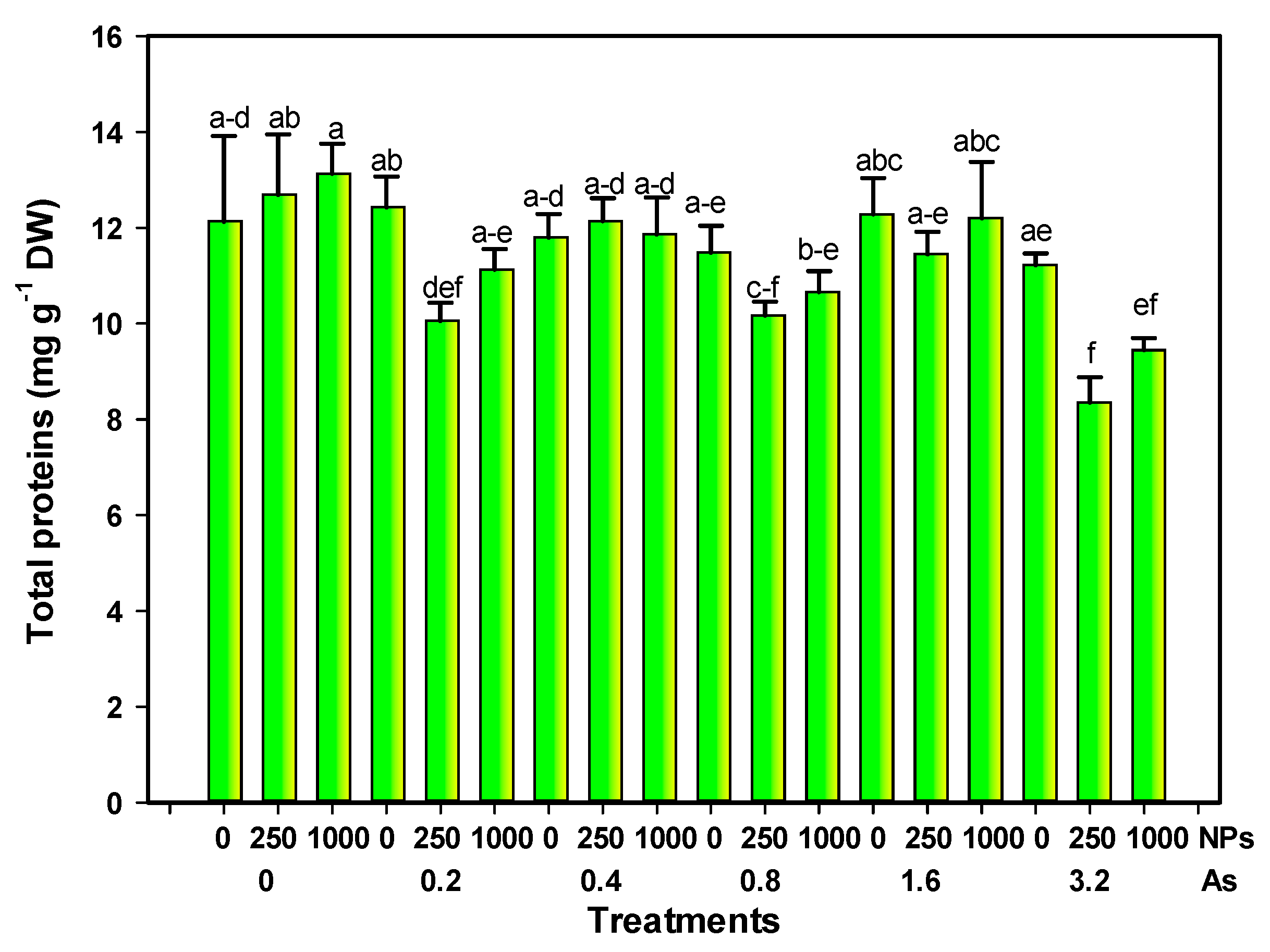
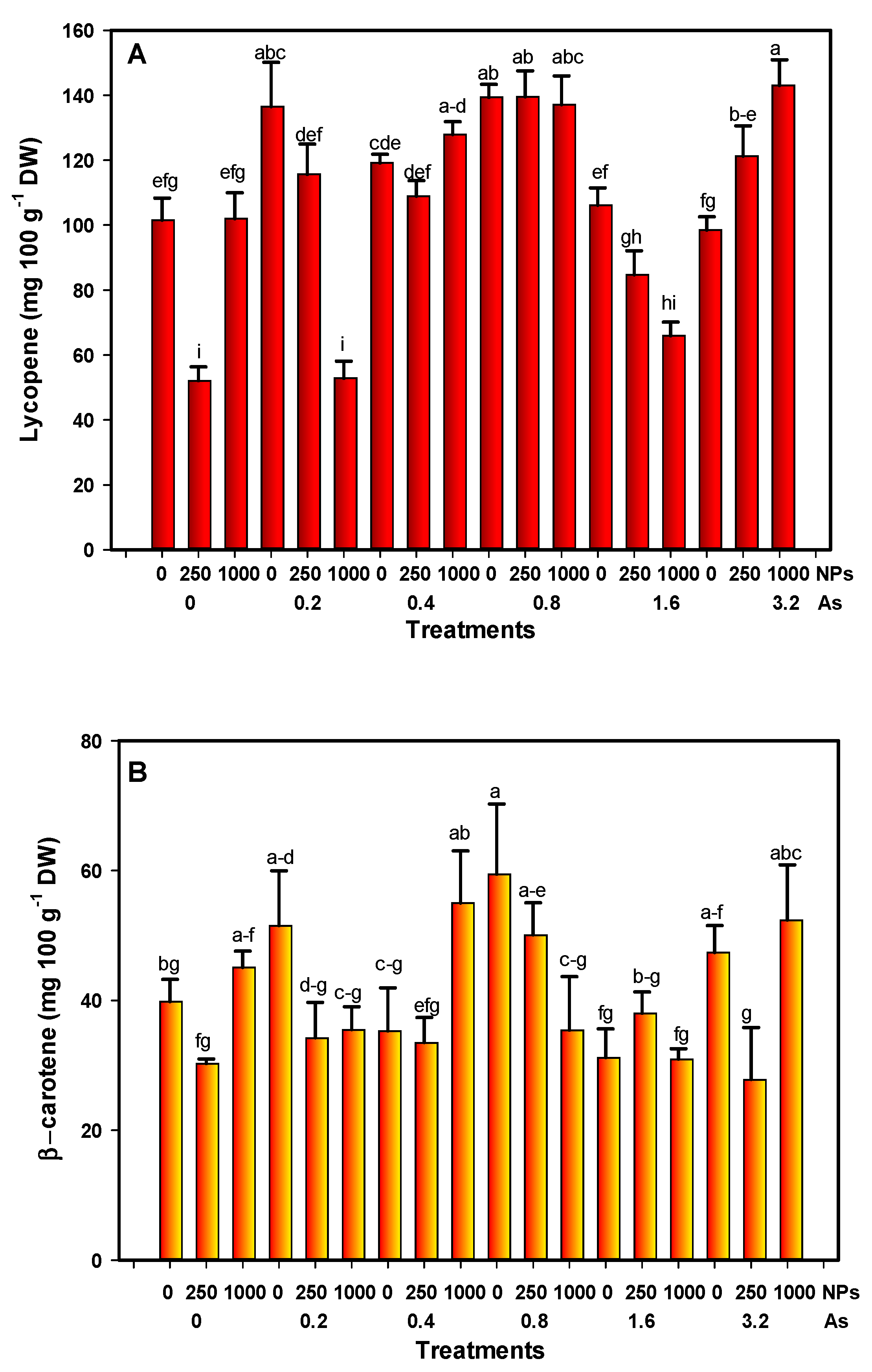
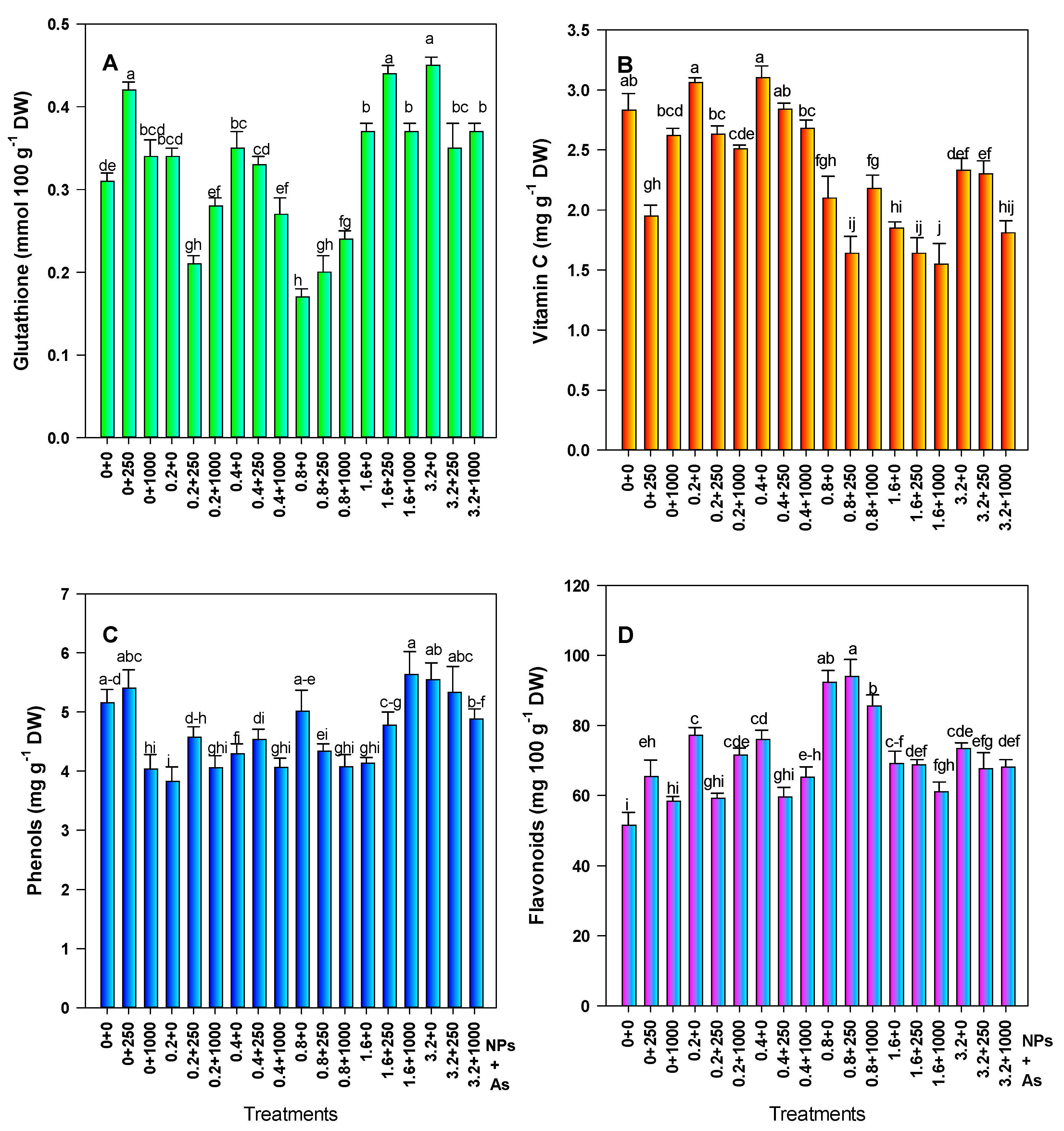
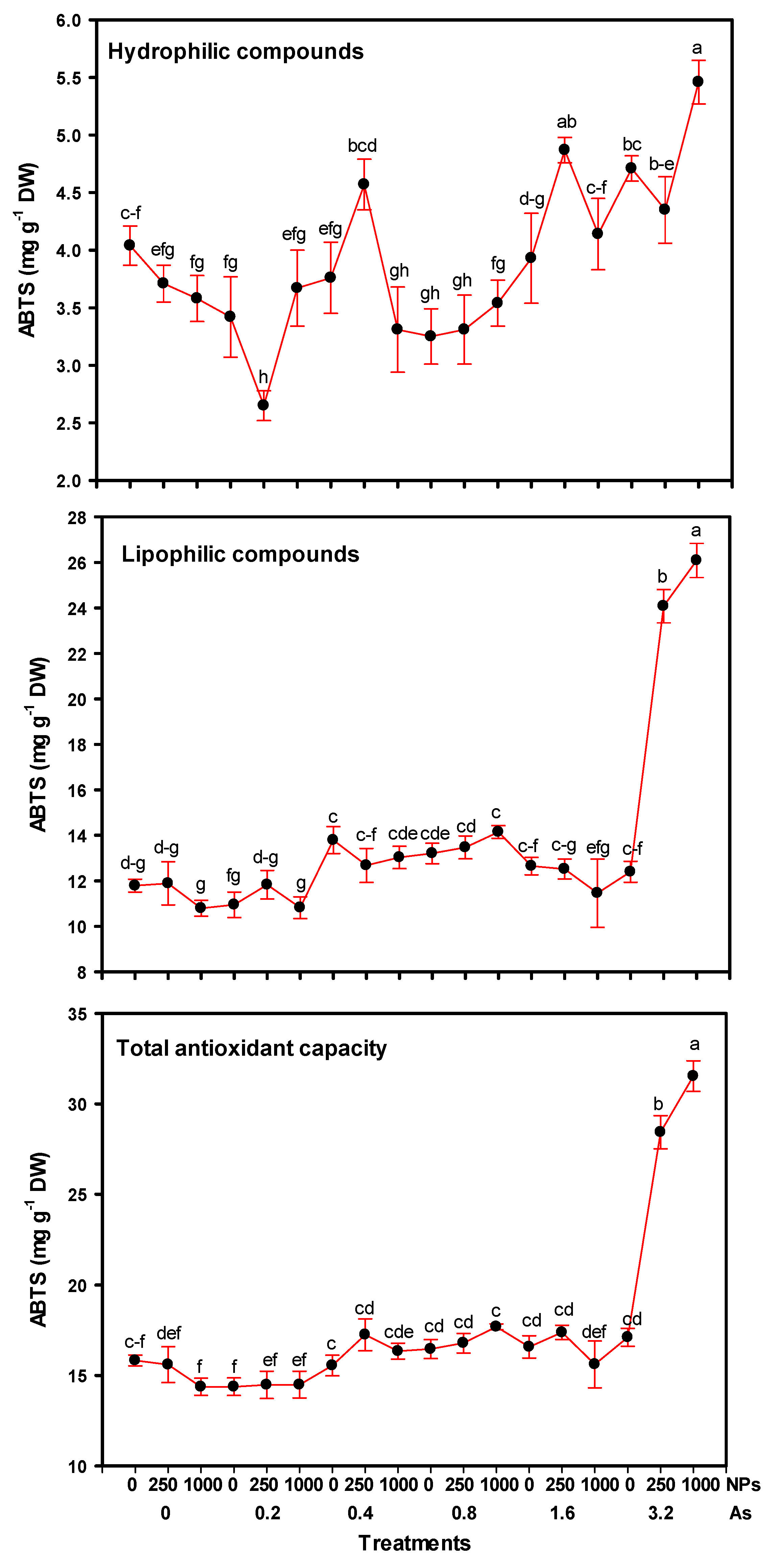
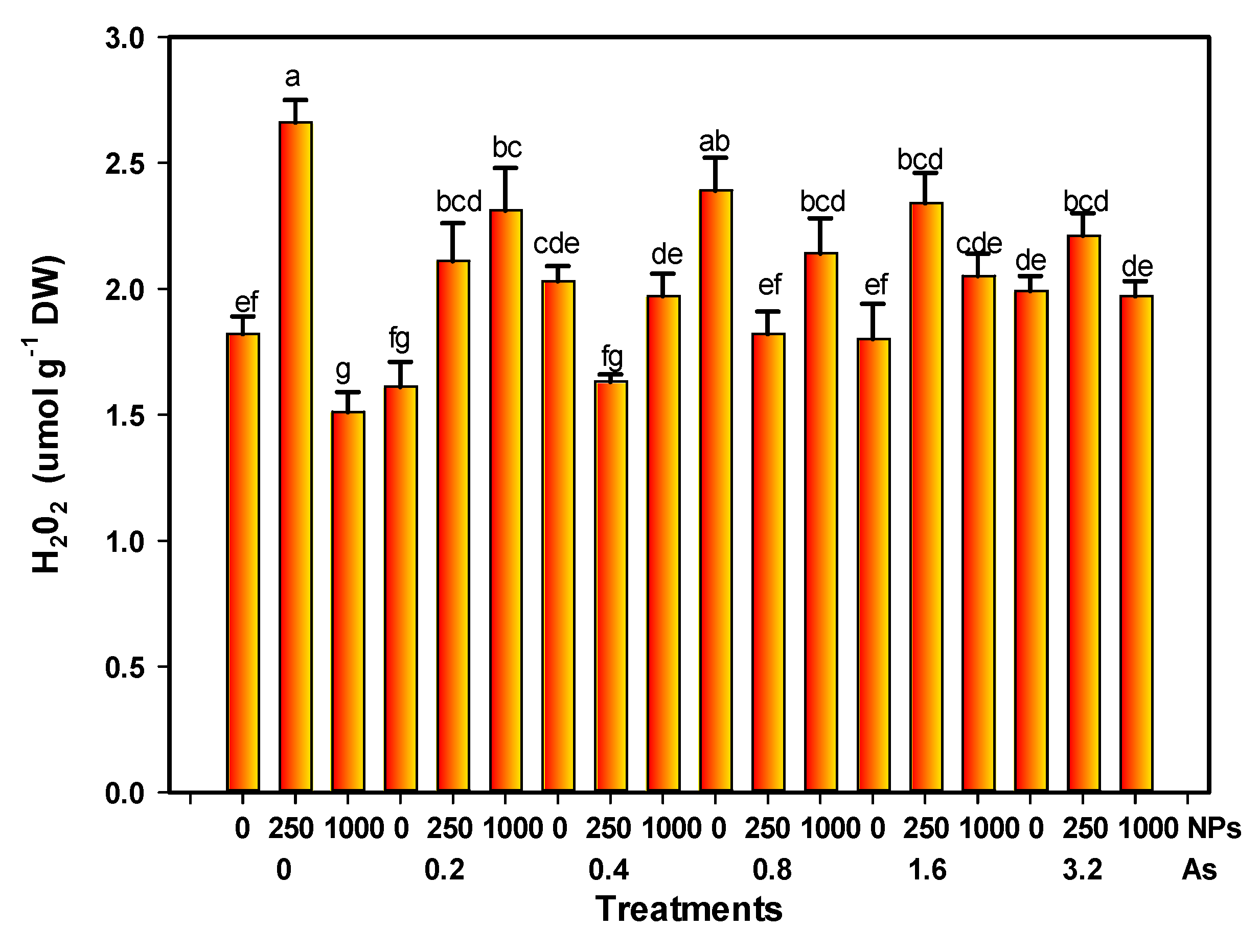
| As | SiO2 NPs | Firmness | TSS | pH | EC | ORP |
|---|---|---|---|---|---|---|
| (mg L−1) | (kg cm−1) | (°Brix) | (mS cm−1) | (mV) | ||
| 0 | 0 | 4.60 ± 0.26 ab | 5.20 ± 0.28 ab | 4.75 ± 0.04 a | 3.98 ± 0.27 a–d | 54.83 ± 1.25 b |
| 250 | 4.21 ± 0.85 b | 5.50 ± 0.34 a | 4.57 ± 0.02 bcd | 3.81 ± 0.15 bcd | 61.00 ± 1.79 a | |
| 1000 | 4.85 ± 0.46 ab | 5.33 ± 0.33 ab | 4.51 ± 0.02 def | 4.17 ± 0.16 abc | 51.50 ± 1.15 bc | |
| 0.2 | 0 | 5.88 ± 0.56 ab | 5.25 ± 0.17 ab | 4.53 ± 0.02 b–f | 3.42 ± 0.47 d | 50.17 ± 2.09 c |
| 250 | 4.35 ± 0.70 b | 5.17 ± 0.17 ab | 4.52 ± 0.03 b–f | 3.98 ± 0.24 a–d | 50.00 ± 1.69 cd | |
| 1000 | 5.88 ± 0.47 ab | 5.33 ± 0.21 ab | 4.51 ± 0.02 c–f | 4.30 ± 0.28 ab | 51.00 ± 0.89 bc | |
| 0.4 | 0 | 4.97 ± 1.01 ab | 5.28 ± 0.16 ab | 4.58 ± 0.02 b | 3.51 ± 0.29 cd | 41.00 ± 1.32 e |
| 250 | 5.45 ± 0.89 ab | 5.05 ± 0.03 ab | 4.52 ± 0.02 b–f | 4.19 ± 0.25 abc | 45.67 ± 0.92 d | |
| 1000 | 5.48 ± 0.24 ab | 5.50 ± 0.18 a | 4.51 ± 0.02 def | 3.87 ± 0.48 a–d | 40.17 ± 1.01 e | |
| 0.8 | 0 | 5.27 ± 0.71 ab | 5.37 ± 0.20 ab | 4.47 ± 0.02 f | 4.22 ± 0.11 ab | 38.17 ± 1.96 efg |
| 250 | 5.73 ± 0.57 ab | 5.23 ± 0.09 ab | 4.54 ± 0.02 b–e | 4.50 ± 0.14 ab | 38.83 ± 0.48 ef | |
| 1000 | 5.25 ± 0.54 ab | 5.17 ± 0.29 ab | 4.51 ± 0.01 c–f | 4.41 ± 0.18 ab | 39.83 ± 1.82 e | |
| 1.6 | 0 | 5.31 ± 0.92 ab | 5.42 ± 0.20 ab | 4.52 ± 0.02 c–f | 4.25 ± 0.10 ab | 36.67 ± 1.87 efg |
| 250 | 6.18 ± 0.39 a | 4.83 ± 0.17 b | 4.55 ± 0.02 b–e | 4.15 ± 0.13 abc | 37.17 ± 1.19 efg | |
| 1000 | 4.78 ± 0.56 ab | 5.33 ± 0.36 ab | 4.55 ± 0.01 b–e | 4.00 ± 0.36 a–d | 35.00 ± 2.35 fgh | |
| 3.2 | 0 | 4.86 ± 0.57 ab | 5.42 ± 0.20 ab | 4.50 ± 0.04 ef | 4.14 ± 0.12 abc | 31.83 ± 2.15 h |
| 250 | 5.73 ± 0.77 ab | 5.37 ± 0.20 ab | 4.54 ± 0.02 b–e | 4.53 ± 0.11 a | 36.83 ± 1.47 efg | |
| 1000 | 5.72 ± 0.46 ab | 5.03 ± 0.03 ab | 4.58 ± 0.02 bc | 4.15 ± 0.25 abc | 34.17 ± 1.72 gh | |
| CV (%) | 30.05 | 10.30 | 1.29 | 14.92 | 9.04 | |
| ABTS H | ABTS L | TAC ABTS | H2O2 | Lycopene | Β-Carotene | Proteins | Vitamin C | Glutathione | Phenols | Flavonoids | ORP | |
|---|---|---|---|---|---|---|---|---|---|---|---|---|
| As | 0.53 ** | 0.67 ** | 0.71 ** | 0.08 NS | 0.14 NS | −0.02 NS | −0.35 * | −0.42 ** | 0.41 ** | 0.35 * | 0.08 NS | −0.71 ** |
| SiO2 NPs | 0.04 NS | 0.14 NS | 0.14 NS | −0.04 NS | −0.12 NS | 0.02 NS | −0.04 NS | −0.18 NS | −0.11 NS | −0.14NS | −0.13 NS | ‒0.05 |
| ABTS H | 0.37 * | 0.53 ** | 0.04 NS | −0.08 NS | 0.01 NS | 0.10 NS | −0.19 NS | 0.52 ** | 0.33 * | −0.1 NS | −0.27 * | |
| ABTS L | 0.99 ** | 0.10 NS | 0.33 * | −0.03 NS | −0.46 ** | −0.22 * | 0.07 NS | 0.16 NS | 0.04 NS | −0.38 ** | ||
| TAC ABTS | 0.10 NS | 0.29 * | −0.02 NS | −0.41 ** | −0.24 * | 0.16 NS | 0.20 * | 0.02 NS | −0.40 ** | |||
| H2O2 | −0.22 * | −0.15 NS | −0.04 NS | −0.21 * | 0.05 NS | 0.31 * | 0.19 NS | 0.02 NS | ||||
| Lycopene | 0.19 NS | −0.19 NS | 0.17 NS | −0.37 * | 0.16 NS | 0.39 ** | −0.28 * | |||||
| β–carotene | 0.05 NS | −0.03 NS | −0.19 NS | 0.01 NS | 0.22 * | −0.10 NS | ||||||
| Proteins | 0.11 NS | 0.18 NS | −0.06 NS | −0.04 NS | 0.22 * | |||||||
| Vitamin C | −0.09 NS | −0.22 * | 0.17 NS | 0.38 ** | ||||||||
| GSH | 0.25 * | −0.28 * | 0.11 NS | |||||||||
| Phenols | −0.07 NS | −0.12 NS | ||||||||||
| Flavonoids | −0.33 * | |||||||||||
| Significant Correlation | No significance | |||||||||||
© 2019 by the authors. Licensee MDPI, Basel, Switzerland. This article is an open access article distributed under the terms and conditions of the Creative Commons Attribution (CC BY) license (http://creativecommons.org/licenses/by/4.0/).
Share and Cite
González-Moscoso, M.; Martínez-Villegas, N.V.; Cadenas-Pliego, G.; Benavides-Mendoza, A.; Rivera-Cruz, M.d.C.; González-Morales, S.; Juárez-Maldonado, A. Impact of Silicon Nanoparticles on the Antioxidant Compounds of Tomato Fruits Stressed by Arsenic. Foods 2019, 8, 612. https://doi.org/10.3390/foods8120612
González-Moscoso M, Martínez-Villegas NV, Cadenas-Pliego G, Benavides-Mendoza A, Rivera-Cruz MdC, González-Morales S, Juárez-Maldonado A. Impact of Silicon Nanoparticles on the Antioxidant Compounds of Tomato Fruits Stressed by Arsenic. Foods. 2019; 8(12):612. https://doi.org/10.3390/foods8120612
Chicago/Turabian StyleGonzález-Moscoso, Magín, Nadia Valentina Martínez-Villegas, Gregorio Cadenas-Pliego, Adalberto Benavides-Mendoza, María del Carmen Rivera-Cruz, Susana González-Morales, and Antonio Juárez-Maldonado. 2019. "Impact of Silicon Nanoparticles on the Antioxidant Compounds of Tomato Fruits Stressed by Arsenic" Foods 8, no. 12: 612. https://doi.org/10.3390/foods8120612
APA StyleGonzález-Moscoso, M., Martínez-Villegas, N. V., Cadenas-Pliego, G., Benavides-Mendoza, A., Rivera-Cruz, M. d. C., González-Morales, S., & Juárez-Maldonado, A. (2019). Impact of Silicon Nanoparticles on the Antioxidant Compounds of Tomato Fruits Stressed by Arsenic. Foods, 8(12), 612. https://doi.org/10.3390/foods8120612









